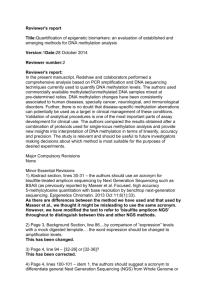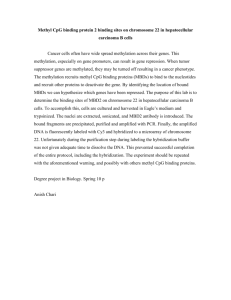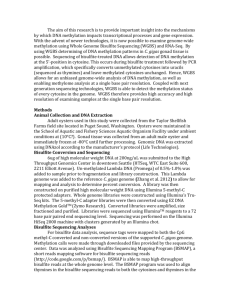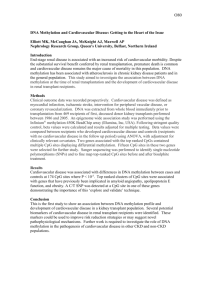Epigenetics - Tresch Group
advertisement
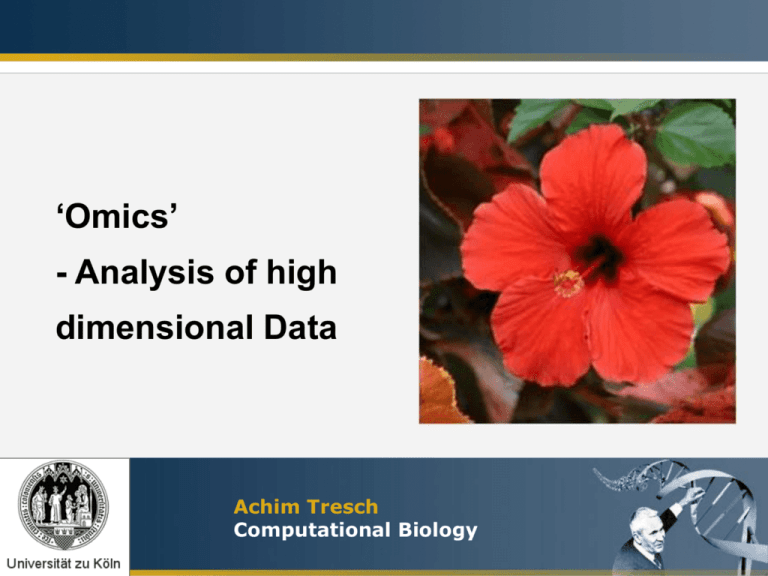
‘Omics’
- Analysis of high
dimensional Data
Achim Tresch
Computational Biology
Epigenetics
Slides: Doug Brutlag, Stanford University School of Medicine
http://biochem158.stanford.edu/Epigenetics.html
Epigenetics
• C.H. Waddington coined the term
epigenetics to mean above or in
addition to genetics to explain
differentiation.
• How do different adult stem cells know
their fate?
– Myoblasts can only form muscle cells
– Keratinocytes only form skin cells
– Hematopoetic cells only become
blood cells
– But all have identical DNA sequences.
Epigenetics
• Modern definition is nonsequence dependent
inheritance.
• How can identical twins have
different natural hair colors?
• How can a single individual
have two different eye
colors?
Mosaicism: One Eye, two Colors
• How can identical twin liter mates show different coat colors?
• How can just paternal or maternal traits be expressed in
offspring? This is called genetic imprinting.
• How can females express only one X chromosome per cell?
• How can acquired traits be passed on to offspring?
The ‘epigenetic’ code
DNA Methylation &
Histone Modifications
Paula Vertino, Henry Stewart Talks
Methylation of Cytosine in DNA
cytosine
Paula Vertino, Henry Stewart Talks
5-methyl cytosine
Methylation of Cytosine in DNA
Paula Vertino, Henry Stewart Talks
DNA Methylation (Biochemistry)
• CpG dinucleotides are partially methylated in
higher vertebrates
• Human genome: only ~4% of all cytosines
are methylated, but ~ 70%-80% 5mCpG
5-methylcytosine - thymine
• Spontaneous deamination transforms CpG
to TpG or CpA
• Estimated rate (after DNA-repair)[1]: 5.8*10-13
(5.8*10-17) 1/s*sites
cytosine - uracil
[1] Shen et al. (1993) Nucl. Acids Res.
Wikipedia: Deamination,
Thymine, 5-methylcytosine
Methylation of Cytosine in DNA
DNA methylation and Histones
Me
Maintenance of Cytosine Methylation
Maintenance of Cytosine Methylation
Maintenance of Cytosine Methylation
Alex Meissner, Henry Stewart Talks
Maintenance of Cytosine Methylation
Functions of cytosine methylation
DNA Methylation and Cell Differentiation
Alex Meissner, Henry Stewart Talks
DNA Methylation and Cell Differentiation
Alex Meissner, Henry Stewart Talks
DNA Methylation and Cell Differentiation
Nuclear transplantation:
Differentiated Cells can become Totipotent
Methylation level
Methylation Changes During Development
Paula Vertino, Henry Stewart Talks
Methylation level
Methylation Changes During Development
Paula Vertino, Henry Stewart Talks
Methylation level
Methylation Changes During Development
Paula Vertino, Henry Stewart Talks
DNA Methylation and Histone Marks
•DNA methylation– bisulfite sequencing
TTCGCCGACTAA
TTCGCCGAuTAA
•Histone modification
•chromatin immunoprecipitation (ChIP)
© 2013 American Society of Plant Biologists
DNA Methylation and Histone Marks
Using next-generation sequencing, epigenetic modifications can
be identified genome-wide: EPIGENOMICS and METHYLOMICS
GREEN = H3K27me3
PURPLE =
methylcytosine
DNA methylation and Gene Expression
http://www.39kf.com/uploadfiles/image/15902/TXT-20081228163836878.gif
Epigenomics
• Methylation in mammals is mainly targeted at
CpG dinucleotides
• CpGs are either unmethylated or methylated on
both strands
• Hemi-methylated CpGs are rare
Adapted from: http://www.diagenode.com/en/applications/bisulfite-conversion.php
Lars Feuerbach
Bisulfite Sequencing
NH2
NH2
N
N
O
CH3
N
~
~
cytosine
5-methylcytosine
O
NH2
CH3
N
N
~
uracil
O
N
~
No
treatment
TTCGCCGACTAA
Bisulfite
treatment
O
TTCGCCGACTAA
N
O
N
Methylcytosine
Bisulfite
treatment
TTCGCCGAuTAA
When DNA is bisulfite
treated, unmethylated
cytosine is converted to
uracil. Methylcytosine is
not affected.
5-methylcytosine
© 2013 American Society of Plant Biologists
Bisulfite Sequencing
After bisulfite treatment,
unmethylated Cs are read
as T and so differ in the
treated and untreated
samples.
By contrast, methyl-C is
read as C and is the same
as the reference
sequence.
Methylcytosine
TTCGCCGACTAA
No
treatment
Bisulfite
treatment
TTCGCCGACTAA
TTCGCCGAuTAA
TTCGCCGACTAA
TTCGCCGATTAA
© 2013 American Society of Plant Biologists
Reduced Representation Bisulfite Sequencing
RRBS-Seq
• DNA is digested by MSP1 restriction enzyme which
cuts at CCGG sites
• All DNA fragments start with CpG
• Alignment is simplified as reads have to map to MSP1
restriction sites
• Reads are enriched for CpG rich areas
TATGC
CGGATGTTTTGTACTAGGATAAC
http://www.neb.com/nebecomm/products/productR0106asp
CGGAT
Alignment of BS converted reads
Standard alignment to the reference is not possible. Adapted
alignment procedures have lower accuracy.
Reference
Read out
Alignment of BS converted reads
Key concept:
- Convert the reference genome in silico as bilufite
treatment does
- Perform conversion for
+ strand and – strand
- Then align reads against
both genomes
Tools supporting the
alignment of BS reads:
- Bismark
- BSMAP
- BS Seeker
Simon Andrews, Bioinformatics 2011
Alignment of BS converted reads
H = IUPAC
character for the
letters {A,C,T}
Simon Andrews, Bioinformatics 2011
Description of DNA methylation
Pearl-Necklace diagrams (lollipop plots)
Measure unmethylated Cs (#C)
Measure methylated Cs (#5mC)
Report the methylation ratio
#5mC
#5mC # C
The Tomato Methylome
Density of methylated DNA and other features in chromosomes of the tomato fruit
Reprinted by permission from Macmillan Publishers Ltd: Zhong, S., Fei, Z., Chen, Y.R., Zheng, Y., Huang, M., Vrebalov, J., McQuinn, R., Gapper, N., Liu, B., Xiang, J., Shao, Y., and
Giovannoni, J.J. (2013). Single-base resolution methylomes of tomato fruit development reveal epigenome modifications associated with ripening. Nat Biotechnol. [in press].
© 2013 American Society of Plant Biologists
Characterize deamination by repetitive sequences
Evolution of CpG content in repetitive sequences
Peifer et al. (2008) Bioinformatics
Evolution of CpG-rich promoters
• AT-rich promoters in
bacteria
• Mixed promoters in worm
and fly
• Increasing GC and CpG
content in mosquito
• Small CpG islands in fish
• Broad CpG islands in
humans
Khuu et al., PNAS, Sep. 2007
Promoter Types in Humans
Weber et al., 2007, Nat. Genet.
Model of CpG island evolution
CpG frequency
Ancestral Genome
8,00%
7,00%
6,00%
5,00%
4,00%
3,00%
2,00%
1,00%
0,00%
1
3
5
7
9
11
13
15
17
19
21
23
Position on chromosome
25
27
29
31
33
35
Model of CpG island evolution
CpG frequency
After 0.1 transversions
8,00%
7,00%
6,00%
5,00%
4,00%
3,00%
2,00%
1,00%
0,00%
1
3
5
7
9
11
13
15
17
19
21
23
Position on chromosome
25
27
29
31
33
35
Model of CpG island evolution
CpG frequency
Observable genome
8,00%
7,00%
6,00%
5,00%
4,00%
3,00%
2,00%
1,00%
0,00%
1
3
5
7
9
11
13
15
17
19
21
23
Position on chromosome
25
27
29
31
33
35
CpG island definitions
CpG frequency
Observable genome
8,00%
7,00%
6,00%
5,00%
4,00%
3,00%
2,00%
1,00%
0,00%
1
3
5
7
9
11
13
15
17
19
21
23
25
27
29
31
Position on chromosome
CpG content
TakeiJones
CpG island definition:
1. GC-content
2. Ratio observed over expected CpG frequency
3. Minimal Length
Gardiner-Gardener
33
35
CpG islands
• CpG dinucleotides are rare in the
human genome
• CpG Islands are exceptions
• Elevated GC content and CpG
frequency
• 50-60% of promoters are CpG
islands
• Methylation level anti-correlated
to expression in HCP promoters
• Cause or consequence ?
CpG islands and chromatin
Caiafa and Zampieri,(2005) JCB
Histone modifications
•
How to read the nomenclature:
–
–
–
Histone protein (H3)
Position in tail (K9)
Modification type (me3)
Füllgrabe et al., 2011,
Oncogene
Histone code
H3K4me2-me3
Active transcription, near TSSs
H3K9me3
Heterochromatin
H3K9ac
Euchromatin, near TSSs
H3K27me3
Polycomb marker, closes chromatin
H4K16ac
Higher order chromatin, repeat methylation
H4K20me3
Heterochromatin
•Füllgrabe et al., 2011,
Oncogene
Interplay
•Ceder&Bergman,2009,Nature Rev Genet
Allele-unspecific DNA methylation
Allele-specific DNA methylation
Imprinting
•
•
•
Origin-of-allele-specific gene expression
Exception from Mendel’s inheritance rules
Mediated by methylation of imprinting control regions
University of Florida: http://www.peds.ufl.edu/divisions/genetics/teaching
Allele specific – Histone modifications
Adapted from: http://genomebiology.com/content/figures/gb-2005-6-6-113-1-l.jpg
Reference Methylomes – Laurent et al.
• Laurent data on human embryonic stem cells
and fibroblasts
• 70% of all CpGs covered by at least 3 reads
Laurent et al. Genome Research 2010
Reference methylomes – Molaro et al.
• Male germline methylome for human and
chimpanzee
• Direct comparison to Laurent et al. data
Molaro et al. Cell 2011
ENCODE, IHEC and Epigenome Roadmap
• One Genome many Epigenomes
• Cataloguing epigenetic modifications in
different tissues
Translation into NGS signals
Translation of epigenetic signals
• Capture-seq
– Chromatin Immunoprecipitation (ChIP)
– Metylated DNA Immunoprecipitation (MeDIP)
– MBD chromatography
• Conversion-seq
– Bisulfite sequencing (methyl-seq)
– Reduced representation bisulfite sequencing
(RRBS)
– Ultra-deep amplicon sequencing
Two signal types
•
Coverage
Enrichment
Sequencing
Mapping
Peak calling
Sequence
Preparation
Sequencing
Special mapping
Decoding
Enrichment-seq – Workflow I
Epigenetically modified regions
Genome
DNA Library
Preparation
Enrichment-seq – Workflow II
Enrichment
Enrichment-seq – Workflow III
Mapping
Genome
Enrichment-seq – Workflow IV
Genome
Methylated DNA immunoprecipitation
•http://en.wikipedia.org/wiki/Methylated_DNA_immunoprecipitation
BiQ Analyzer HT
Lutsik P et al. Nucl. Acids Res. 2011;nar.gkr312
Allele-specific methylation analysis pipeline
Matthias Bieg et al., in preparation
Summary
• Epigenetics plays a key role in cell function
• Each cell type has its own epigenome
• Epigenetic modifications are can be converted to NGS signals
• Bioinformatic in depth analysis of epigenomes is still in its
infancy
References
•Laurent, L.; Wong, E.; Li, G.; Huynh, T. et al
•“Dynamic changes in the human methylome
•during differentiation”
•Genome Research (2010) 20 320-331
•Molaro, A.; Hodges, E.; Fang, F.; Song, Q. et al.
•“Sperm Methylation Profiles Reveal
•Features of Epigenetic Inheritance
•and Evolution in Primates”
•Cell (2011) 146 1029-1041
•Lutsik,P.; Feuerbach, L. ; Arand, J.; Lengauer, T. et al.
•“BiQ Analyzer HT: locus-specific analysis of DNA methylation by high-throughput bisulfite sequencing”
•NAR (2011)
Environment can Influence Epigenetic Changes
Emma Whitelaw, Henry Stewart Talks
Hongerwinter 1944
•
•
•
•
German’s blocked food to the Dutch in the winter of 1944.
Calorie consumption dropped from 2,000 to 500 per day for 4.5 million.
Children born or raised in this time were small, short in stature and had
many diseases including, edema, anemia, diabetes and depression.
The Dutch Famine Birth Cohort study showed that women living during
this time had children 20-30 years later with the same problems despite
being conceived and born during a normal dietary state.

